Artificial intelligence (AI) technology has emerged as a contentious topic in the past several years. Love it or hate it, it’s undeniable that AI is becoming prevalent in our everyday lives. From the personal, like dealing with AI customer service, to the communal, such as its impact on political media, AI can now be found in every facet of our society. Until recently, I had not seen museums meaningfully engage with this groundbreaking but controversial technology, but within the past few months I have visited several local museums that discuss the uses and effects of AI from diverse approaches.
The AI: Mind the Gap exhibit at the MIT Museum in Cambridge tackles the subject of AI from historical, philosophical, and technological perspectives. The exhibition’s introduction focuses on early research into artificial intelligence and machine learning from computer science pioneers such as Claude Shannon and Marvin Minsky, grounding artificial intelligence as an existing field of study from the 1950’s onward rather than a recent discovery. The rest of the exhibit allows visitors to interact with various forms of AI from ChatGPT poetry to deep fake presidents to friendly social robots. This interactivity enables visitors to learn about AI technology through direct experience while text, audio, and visuals explain how the technology functions, how it is intended to be used, and how it may be used unethically. For example, there is a game in the deep fake section of the exhibit where visitors can guess whether a short video clip is “real” or “fake.” This holistic and engaging approach makes the potentially intimidating topic of AI more accessible while the educational focus of the exhibit promotes technological and media literacy.
The Broad Discovery Center, a small museum attached to the Broad Institute of MIT and Harvard in Cambridge, has a different focus. While most news centers on generative artificial intelligence–the type of AI that creates text and images–the Broad Institute is a biomedical research organization and its museum showcases AI’s diverse applications in research and medicine. Researchers are increasingly using machine learning AI to sift through and find patterns in enormous data sets, tasks which would be too time-consuming or intensive for humans. The main case study discussed in the museum features researchers’ employing machine learning to analyze medical images of the heart and patient genetics which resulted in promising findings for future diagnostics of cardiovascular conditions. While the Broad Discovery Center does not confront the ethical implications of AI, the museum does educate visitors on the many interdisciplinary applications of this technology and demystifies how scientists use AI as a tool.
In September and October 2024, the Griffin Museum of Photography in Winchester presented an exhibit called Artificial Intelligence: Disinformation in a Post Truth World which examined images created or enhanced by generative AI as well as ambiguous images that were real but bore AI elements. The museum took an arts and society-based approach to the topic of artificial intelligence by asking visitors to consider AI as everything from an additional tool in an artistic toolkit to a form of dangerous history-altering censorship and instrument of the surveillance state. As part of the exhibition programming, I attended a panel at the Griffin Museum regarding the ethics of AI in art and media with speakers Jonathan Zittrain, Harvard professor of law, public policy, and computer science, and Judith Donath, writer and media arts expert. Their discussion covered the history of ethics in photography, faked photography through the ages, the psychology behind believing faked images, and a need for improved media literacy. Tempers ran a hot in the audience with both pro-AI and anti-AI attendees asking the speakers pointed questions, but this passion and controversy further confirmed my belief that museums in general need to do a better job at addressing the divisive topic of artificial intelligence.
Why is it important that museums talk about AI? Research continues to show that museums are the most trusted institutions in the US for fact-based information. Meanwhile, recent studies suggest that a majority of Americans do not trust artificial intelligence and do not trust tech companies and the government to effectively regulate the technology. In the news and public forums, AI is often discussed with fear and suspicion while being identified as a source of misinformation. Though these concerns are justified, this approach does little to educate the public on AI as a technology and fails to empower us to distinguish AI from reality, fact from fiction. Critical thinking and media literacy, already necessary skills, are becoming increasingly important in the age of AI, and museums are uniquely positioned to reach the public on these issues. Backed by significant public trust, museums should work to dispel AI myths and misinformation while arming visitors with the knowledge and confidence they need to engage with AI in their everyday lives.



